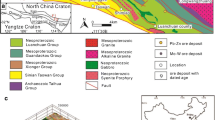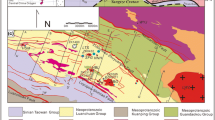Abstract
The Wulong gold district (WGD) is located at the northeastern margin of the North China Carton (NCC) on the Liaodong Peninsula, China. The results of early mineral exploration, mining, and metallogenic modeling research show that gold deposition was associated with lithospheric thinning of the NCC and the emplacement of voluminous Early Cretaceous intrusions. In this study, multi-source information on the ore formation and geology (including geophysical, geochemical, and remote sensing data) was used to construct two-dimensional (2D) prospectivity maps at multiple levels (surface (0 m), − 500 m, − 1000 m, − 1500 m, − 2000 m, − 2500 m, and − 3000 m) for subsurface mineral exploration in the WGD. The methodology employed consists of four steps. Firstly, three-dimensional (3D) geological and geophysical models were constructed using UBC-GIF and SKUA-GOCAD software. 3D geophysical modeling included 3D gravity and magnetic inversions, and 3D resistivity models were based on 2D magnetotelluric (MT) inversion. Secondly, multi-source, ore-forming, and geoscientific data were integrated using radial basis function link net modeling technology within ArcGIS-SDM. Thirdly, multiple-level 2D prospectivity maps were integrated using the discrete smooth interpolation method within the SKUA-GOCAD software to produce 3D prospecting models. Finally, posterior probabilities were classified to delineate 3D exploration targets using the concentration–volume fractal method (GeoCube software, v. 2.0). The results suggest that: (1) the Early Cretaceous intrusions are key ore-forming and ore-controlling objects within the WGD, and a potential target is the western part of the Sanguliu intrusion at depths from 1000 to 3000 m, in the zone where the Wulong and Yangjia gold deposits cross; (2) there are potential targets within 2500 m of the Wulong gold deposit; however, (3) there are no potential targets from 1000 to 3000 m in the Sigdaogou gold deposit.


















Similar content being viewed by others
References
Afzal, P., Ahari, H. D., Omran, N. R., & Aliyari, F. (2013). Delineation of gold mineralized zones using concentration-volume fractal model in Qolqoleh gold deposit, NW Iran. Ore Geology Reviews,55, 125–133.
Afzal, P., Alghalandis, Y. F., Khakzad, A., Moarefvand, P., & Omran, N. R. (2011). Delineation of mineralization zones in porphyry Cu deposits by fractal concentration-volume modeling. Journal of Geochemical Exploration,108(3), 220–232.
Bonham-Carter, G. F. (1994). Geographic information systems for geoscientists: modelling with GIS. Pergamon: Elsevier.
Carranza, E. J. M. (2011). From predictive mapping of mineral prospectivity to quantitative estimation of number of undiscovered prospects. Resource Geology,61(1), 30–51.
Carranza, E. J. M., & Sadeghi, M. (2010). Predictive mapping of prospectivity and quantitative estimation of undiscovered VMS deposits in Skellefte district (Sweden). Ore Geology Reviews,38, 219–241.
Carranza, E. J. M., Woldai, T., & Chikambwe, E. M. (2005). Application of data-driven evidential belief functions to prospectivity mapping for aquamarine-bearing pegmatites, Lundazi district, Zambia. Natural Resources Research,14, 47–63.
Costa e Silva, E., Silva, A. M., Bemfica Toledo, C. L., Mol, A. G., Otterman, D. W., & de Souza, S. R. C. (2012). Mineral potential mapping for orogenic gold deposits in the Rio Maria granite greenstone terrane, Southeastern Pará State, Brazil. Economic Geology,107(7), 1387–1402.
Feng, H., Shen, P., Zhu, R., Li, C., Ma, G., & Pan, H. (2019). Geology and He-Ar-S-Pb isotope constraints on the genesis of the Sidaogou gold deposit in Liaodong Peninsula, northeastern North China Craton. Ore Geology Reviews. https://doi.org/10.1016/j.oregeorev.2019.103080.
Huang, L., Wang, G., Carranza, E. J. M., Du, J., Li, J., Zhou, Z., et al. (2019). Multi-scale numerical simulation and 3D modeling for deep mineral exploration in the Jiaojia Gold District, China. Natural Resources Research. https://doi.org/10.1007/s11053-019-09608-z.
Ji, Z. J., Wu, X. G., & Huang, J. P. (2009). Study on structure-controlling regularities of mineralization and geological criteria for prospectivity in Wulong gold deposit. Gold,30, 19–22. (in Chinese with English abstract).
Joly, A., Porwal, A., McCuaig, T. C., Chudasama, B., Dentith, M. C., & Aitken, A. R. A. (2015). Mineral systems approach applied to GIS-based 2D-prospectivity modelling of geological regions: Insights from Western Australia. Ore Geology Reviews,71, 673–702.
Li, N., Song, X., Li, C., Xiao, K., Li, S., & Chen, H. (2019). 3D geological modeling for mineral system approach to GIS-based prospectivity analysis: Case study of an MVT Pb-Zn deposit. Natural Resources Research. https://doi.org/10.1007/s1053-018-9429-9.
Li, R., Wang, G., & Carranza, E. J. M. (2016). GeoCube: A 3D mineral resources quantitative prediction and assessment system. Computers & Geosciences,89, 161–173.
Liaoning Geological Survey (LNGS). (2003). Geological report of the surrounding area of Wulong gold deposit (245 pp). Dandong. Unpublished document (in Chinese).
Liu, J., Wang, S. L., Li, T. G., Yang, Y., Liu, F. X., Li, S. H., et al. (2018). Geochronology and isotopic geochemical characteristics of Wulong gold deposit in Liaoning Province. Mineral Deposits. https://doi.org/10.16111/j.0258-7106.2018.04.002. (in Chinese with English abstract).
McCuaig, T. C., Beresford, S., & Hronsky, J. (2010). Translating the mineral systems approach into an effective exploration targeting system. Ore Geology Reviews,38, 128–138.
Nielsen, S. H. H., Cunningham, F., Hay, R., Partington, G., & Stokes, M. (2015). 3D prospectivity modelling of orogenic gold in the Marymia Inlier, Western Australia. Ore Geology Reviews,71, 578–591.
Nykänen, V. (2008). Radial basis functional link nets used as a prospectivity mapping tool for orogenic gold deposits within the central Lapland greenstone belt, northern Fennoscandian shield. Natural Resources Research,17(1), 29–48.
Payne, C. E., Cunningham, F., Peters, K. J., Nielsen, S., Puccioni, E., Wildman, C., et al. (2015). From 2D to 3D: Prospectivity modelling in the Taupo volcanic zone, New Zealand. Ore Geology Reviews,71, 558–577.
Porwal, A., Carranza, E. J. M., & Hale, M. (2003). Artificial neural networks for mineral-potential mapping: A case study from Aravalli Province, Western India. Natural Resources Research,12(3), 155–171.
Roshanravan, B., Aghajani, H., Yousefi, M., & Kreuzer, O. (2019). Particle swarm optimization algorithm for neuro-fuzzy prospectivity analysis using continuously weighted spatial exploration data. Natural Resources Research,28, 309–325.
Tao, G., Wang, G., & Zhang, Z. (2019). Extraction of mineralization-related anomalies from gravity and magnetic potential fields for mineral exploration targeting: Tongling Cu (Au) district, China. Natural Resources Research,28(2), 461–486.
Tessema, A. (2017). Mineral systems analysis and artificial neural network modeling of chromite prospectivity in the western limb of the Bushveld Complex, South Africa. Natural Resources Research,26(4), 465–488.
Tissari, S., Nykänen, V., Lerssi, J., & Kolehmainen, M. (2007). Classification of soil groups using weights-of-evidence method and RBFLN-neural nets. Natural Resources Research,16(2), 159–169.
Wang, C., Wang, G., Liu, J., & Zhang, D. (2019). 3D geochemical modeling for subsurface targets of Dashui Au deposit in Western Qinling (China). Journal of Geochemical Exploration,203, 59–77.
Wang, G., Feng, Y., Carranza, E. J. M., Li, R., Li, Z., Feng, Z., et al. (2016). Typomorphic characteristics of pyrite: Criteria for 3D exploration targeting in the Xishan gold deposit, China. Journal of Geochemical Exploration,164, 136–163.
Wang, G., Li, R., Carranza, E. J. M., Zhang, S., Yan, C., Zhu, Y., et al. (2015). 3D geological modeling for prediction of subsurface Mo targets in the Luanchuan, district, China. Ore Geology Reviews,71, 592–610.
Wang, G., Zhang, S., Yan, C., Song, Y., Sun, Y., Li, D., et al. (2011). Mineral potential targeting and resource assessment based on 3D geological modeling in Luanchuan region, China. Computers & Geosciences,37(12), 1976–1988.
Wei, J., Qiu, X., Guo, D., & Tan, W. (2004). Geochemistry of ore fluids and Rb-Sr isotopic dating for the Wulong gold deposit in Liaoning, China. Acta Geologica Sinica-English Edition,6, 1267–1274.
Wu, F., Yang, J., & Wilde, S. A. (2005). Geochronology petrogenesis and tectonic implications of the Jurassic granites in the Liaodong Peninsula NE China. Chemical Geology,22, 127–156.
Wu, X., Guan, G., & Jin, C. (1990). Geological and geochemical studies on the Sidaogou gold Deposit. Geology and Prospecting,26, 1–6. (in Chinese with English abstract).
Xiang, J., Xiao, K., Carranza, E. J. M., Chen, J., & Li, S. (2019). 3D mineral prospectivity mapping with random forests: A case study of Tongling, Anhui, China. Natural Resources Research. https://doi.org/10.1007/s11053-019-09578-2.
Xiao, S. Y., Zhu, G., Zhang, S., Liu, C., Su, N., Yin, H., et al. (2018). Structural processes and dyke emplacement mechanism in the Wulong gold field, eastern Liaoning. Chinese Science Bulletin,63, 3022–3036. https://doi.org/10.1360/N972018-00682. (in Chinese with English abstract).
Xu, S., Pan, H., Li, C., & Wang, Z. (2015). Evaluation of gold geochemical anomalies in the East Liaoning area. Jilin Geology,34(2), 93–99. (in Chinese with English abstract).
Yang, F., Song, Y., Yang, J., Shen, X., & Gu, Y. (2018). SHRIMP U-Pb age and geochemical characteristics of granites in Wulong-Sidaogou gold deposit. East Liaoning. Geotectonica et Metallogenia,166(42), 940–954. (in Chinese with English abstract).
Yousefi, M., Kreuzer, O. P., Nykänen, V., & Hronsky, J. M. (2019). Exploration information systems-a proposal for the future use of GIS in mineral exploration targeting. Ore Geology Reviews. https://doi.org/10.1016/j.oregeorev.2019.103005.
Yu, B., Zeng, Q., Frimmel, H. E., Wang, Y., Guo, W., Sun, G., et al. (2018). Genesis of the Wulong gold deposit, northeastern North China Craton: Constraints from fluid inclusions, HOS-Pb isotopes, and pyrite trace element concentrations. Ore Geology Reviews,102, 313–337.
Zhang, Z., Wang, G., Carranza, E. J. M., Zhang, J., Tao, G., Zeng, Q., et al. (2019a). Metallogenic model of the Wulong gold district, China, and associated assessment of exploration criteria based on multi-scale geoscience datasets. Ore Geology Reviews. https://doi.org/10.1016/j.oregeorev.2019.103138.
Zhang, Z., Wang, G., Ma, Z., Carranza, E. J. M., Jia, W., Du, J., et al. (2019b). Batholith-stock scale exploration targeting based on multi-source geological and geophysical datasets in the Luanchuan Mo polymetallic district, China. Ore Geology Reviews. https://doi.org/10.1016/j.oregeorev.2019.103225.
Zhang, Z., Wang, G., Ma, Z., & Gong, X. (2017). Interactive 3D modeling by integration of geoscience datasets for exploration targeting in Luanchuan Mo polymetallic district, China. Natural Resources Research,27, 315–346.
Zhu, R., Zhang, H., Zhu, G., Meng, Q., Fan, H., Yang, J., et al. (2017). Craton destruction and related resources. International Journal of Earth Sciences. https://doi.org/10.1007/s00531-016-1441-x.
Acknowledgments
This research was supported by the National Key Research and Development Programs of China (Grant No. 2016YFC0600107), the National Natural Science Foundation of China (Grant No. 41572318), and the China Scholarship Council (201906400019). The authors wish to thank the Manager, Haicheng Qiu, (Wulong Gold Mine, Chifeng Gold Group) and Professors Deming Sha and Dongtao Li (Shenyang Geological Survey of CGS, China) for providing multiple geoscience datasets relating to the WGD. We are also grateful to Professor Lizhen Cheng and Dr. Xueping Dai (Université du Québec en Abitibi-Témiscamingue) for their assistance with geophysical interpretation, which helped to improve the manuscript. Furthermore, we express our sincere gratitude to Dr. Oliver P. Kreuzer and another anonymous reviewers for providing useful comments that helped us to enhance the quality of this paper.
Author information
Authors and Affiliations
Corresponding authors
Rights and permissions
About this article
Cite this article
Zhang, Z., Zhang, J., Wang, G. et al. From 2D to 3D Modeling of Mineral Prospectivity Using Multi-source Geoscience Datasets, Wulong Gold District, China. Nat Resour Res 29, 345–364 (2020). https://doi.org/10.1007/s11053-020-09614-6
Received:
Accepted:
Published:
Issue Date:
DOI: https://doi.org/10.1007/s11053-020-09614-6




